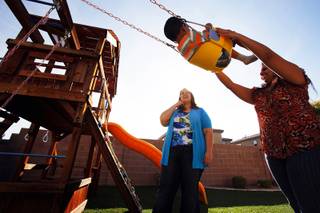
Vinil Narayan, 2, who is autistic, plays on the swing while learning communication with his mother Shika Narayan during a session with Jennifer Murdock, a developmental specialist with Easter Seals Nevada, outside his home in Henderson on Friday, March 16, 2012.
Sunday, March 18, 2012 | 2 a.m.
A 1-year-old with Down syndrome had his every-other-week physical therapy cut in half after the state told his parents there wasn’t money for more frequent sessions.
The state would not pay for a 2-year-old with speech and cognitive disabilities to see therapists more than twice a month. Again officials cited the battered state budget.
A 2-year-old with Down syndrome had her sign language lessons and occupational and physical therapy appointments reduced by half. And instead of being seen at home, her parents take her to a clinic.
These cases and others, detailed in a complaint against the state, triggered an internal state investigation last month. Together they reveal a troubling fact about the impact of Nevada’s austere budget: Services to the state’s youngest children are being curtailed and sometimes not provided at all because of a lack of funds.
About 250 children, from newborns to 3-year-olds, are on waiting lists for such services. For the 2,447 children who are in the state’s program, plans for therapy are often limited, the investigation found. The complaint was brought by the Nevada Disability Advocacy and Law Center.
Among the findings:
• In 76 percent of the cases reviewed, the state did not provide all of the services called for in plans agreed to by state caseworkers and families. This was “due to a lack of available personnel resources” and reduced hours the state had to contract with therapists.
• In 52 percent of cases, the state did not initiate services within 30 days, as required by the federal government. This was “attributable to the lack of personnel resources as a result of the reduction in the amount of funds available for contract services.”
• And on July 1, the state required most children in the program be seen in a clinical setting instead of their home. This shift, approved by the state Legislature to save about $1 million a year, also violates federal law.
•••
The Nevada Early Intervention Services program serves children with development delays, those who, for example, have trouble feeding themselves and speaking. Among those served by the program are children with autism and genetic disorders such as Down syndrome.
The federal government requires states to provide such services. Studies have shown that children’s brains are rapidly developing during these early years and therapy and treatment can have the greatest impact.
Beyond the obvious humanitarian reasons, there’s a fiscal one, as well: Children who receive such services in early years need fewer services from schools and social programs as they grow and develop, and in some cases don’t need any at all.
In Nevada, however, the immediate needs of the recession on the state budget have overshadowed long-term planning.
State officials said the reduction in services, from the summer through the fall, was temporary. Children who weren’t provided with services are now being offered additional services to help make up for the therapy sessions missed, said Mary Liveratti, deputy director with the Department of Health and Human Services.
But Liveratti and other state officials acknowledge that the state’s ability to provide services must fall within a dollar amount set by the governor and Legislature.
“The level of services we can provide is confined by the budget,” said Mary Wherry, deputy for clinical services at the Nevada State Health Division.
That has meant fewer children receive more services, or more children have fewer services.
“It’s a fine line,” Wherry said. “Staff would never be told how many services (a child gets) are based on budget reality.” But, she said, “they know we have limited dollars in the budget.”
•••
The consequences of decisions made in Carson City are rarely noticed by most Nevadans. But for parents of the children who rely on state services to improve their lives, the budget constraints are a real part of their everyday lives.
David, a 15-month-old born with a chromosomal deletion, had been making “amazing progress” with the help of state services, said his mother, Jessica Bischopink of Reno.
“He was sitting up, scooching on his stomach, beginning to crawl — things he would not naturally know how to do,” she said.
This summer, a state worker informed her that his weekly physical therapy sessions would be cut in half.
“I was scared, scared of what would happen to David if he missed the therapies,” she said. “It was a resource that I was counting on, and they were not there for me anymore.”
Through Medicaid, which David is enrolled in, and the family’s private insurance, she counts herself lucky that she was able to fill in the gaps left by the state’s reduction.
In November, the state had restored the cut services and promised to make up for the seven physical therapy sessions he had missed.
But other parents Bischopink knows haven’t been as fortunate, losing services during a critical time when their children’s brains are rapidly developing.
•••
In 2007, the state budgeted $20 million a year for early intervention services. State policymakers have avoided dramatic cuts to the program as the governor and Legislature have gone through rounds budget cuts. As a result, the waiting list has dropped.
Gov. Brian Sandoval and lawmakers in both parties have talked about the importance of early childhood education. But the reality is that the Nevada Early Intervention Services’ budget was cut by $1 million last year, to $25.7 million.
Since 2009, the state’s program had been propped up by $4.9 million from the federal stimulus and a federal grant. But that money has run out.
To save money, the state Legislature in 2011 approved dropping in-home services.
But federal law and regulation require that services be provided “in the natural environment of the child and family,” according to the investigation, which was conducted by the state’s Individuals with Disabilities Education Act office.
Liveratti said the program is still evaluating its procedures. She noted that some group settings, like day care centers, could be used to provide services more efficiently.
Lynne Bigley, an attorney with the Nevada Disability Advocacy and Law Center, met with state officials this month.
“I think everyone acknowledges problems,” she said. “I think they’re committed to address problems in early intervention services.”
She said the agency has agreed to provide information about corrective actions called for in the investigation.
“I left that meeting feeling very encouraged. A lot of attention is going to be given to this issue,” she said, before adding, “a lot of this often boils down to money.”


Join the Discussion:
Check this out for a full explanation of our conversion to the LiveFyre commenting system and instructions on how to sign up for an account.
Full comments policy